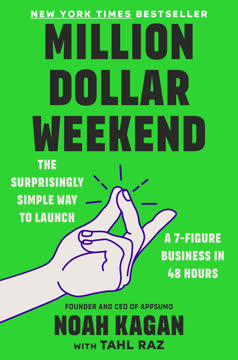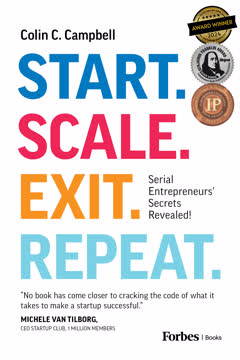Key Takeaways
1. Ideas are everywhere, but action is everything.
Ideas are worthless; acting on them is what is valuable.
Ideas stem from problems. The strongest business ideas often arise from identifying and solving real problems, whether personal frustrations like uncomfortable vacation rental beds or unmet needs like non-toxic sidewalk chalk. Opportunities are abundant, but you must be observant and actively looking for them in your own experiences and the world around you.
Turn ideas into action. Don't just talk about your ideas; take concrete steps to develop them. Write them down, create mini-business plans, and vet them with trusted advisors who understand your industry and can offer honest feedback. Sharing your idea helps refine it, identify potential partners, and perform initial market research to see if others share the problem.
Visualize and name it. Making your idea tangible through visualization is crucial. Define your target market, establish your brand identity, and come up with a name and logo that tell your story and are available legally. Taking these simple actions removes the scary unknown and plots a path forward, making the idea real and actionable.
2. Catch the right wave at the right time.
It’s not the first person who wins but whoever can deliver the fastest.
Timing is essential. Success often depends on having the right idea at the right time, aligning with new technology, market changes, or cultural shifts. Being too early means building a great product with no market (like Barpoint.com before smartphones), while being too late means facing entrenched competition.
Ride the emerging wave. Serial entrepreneurs anticipate future trends by being early adopters and observing societal changes. This allows them to position their companies to catch the wave as it swells, gaining a competitive advantage. The goal is to be ready to deliver quickly and easily when the market is receptive, not necessarily to be the absolute first.
Avoid changing behavior. A key indicator of poor timing is if your idea requires customers to drastically change their existing behavior. Successful innovations often leverage existing behaviors (like Uber using existing taxi-hailing) rather than demanding revolutionary shifts. Focus on solving problems within current customer habits for faster adoption.
3. Build a defensible moat around your idea.
We invest a large portion of our life building our dream company, and the more we succeed, the more our competitors hit us.
Defensibility is key. A scalable idea needs protection to thrive. Building a "moat" around your business makes it difficult for competitors to replicate your success and allows you to maintain market leadership. This requires proactive actions from the start.
Strategies for building a moat:
- Secure a strong, brandable domain name (like Paw.com).
- Pursue legal protections like patents, trademarks, and copyrights.
- Build strategic distribution channels or exclusive partnerships.
- Focus intensely on a niche to become the dominant player (depth before breadth).
Protect your investment. The more successful you become, the more you become a target. Investing in defensibility ensures that your hard work and innovation are protected, allowing you to scale without constantly fending off direct attacks. A strong moat increases your value to potential buyers.
4. Pay your people with love, ownership, and freedom.
You don’t hire for skills, you hire for attitude. You can always teach skills.
Attract growth mindsets. Startups can't compete with large corporations on salary and benefits initially. To attract A players, offer what big companies often lack: transparency, appreciation, and opportunities for personal and professional growth. Be upfront about the risks and rewards.
Compensate beyond salary:
- Love: Recognize greatness, learn about employees' aspirations, and invest in their continuous development. Show genuine care.
- Ownership: Offer annual bonuses tied to performance, stock options, or phantom options to align employee success with company success. Document everything clearly.
- Freedom: Provide flexibility in work hours, location (remote work), and environment (pet-friendly office) to build trust and loyalty.
Hire complements, not clones. Build a diverse team with complementary skills and personality profiles (using tools like DiSC). Avoid being a one-person show; delegate responsibilities based on strengths. This fosters innovation, teamwork, and adaptability, crucial for navigating the constant change of a startup.
5. Cash is oxygen; manage it ruthlessly.
Cash Is the Oxygen That Keeps Your Business Alive
Survival depends on cash flow. Many promising startups fail not due to a lack of good ideas or talent, but simply running out of money. Stress skyrockets when cash is low, leading to desperate, often detrimental, decisions like high-interest loans or cutting essential staff.
Fund your Stage Gates. Determine the exact amount of money needed to hit your first SMART Stage Gate (e.g., reach $10k monthly revenue, develop MVP). Secure this funding upfront, including buffers for unexpected costs. This focused approach prevents running out of oxygen before proving your concept.
Prioritize lean operations. The cheapest way to fund growth is by running efficiently. Delay seeking outside investment as long as possible to avoid dilution. Negotiate everything, leverage outsourcing for repeatable tasks, and constantly look for cost reductions, even during good times, to free up funds for growth drivers like sales and marketing.
6. Scale requires systems, not just instinct.
Companies that scale quickly rely on systems, not on people.
Instinct isn't enough. While entrepreneurial instinct is vital for starting, scaling demands structure and repeatable processes. Many companies fail to grow beyond a certain point because they lack the systems needed to manage increasing complexity and delegate effectively.
Implement strategic systems:
- Strategic Planning: Establish a regular rhythm (annual, quarterly, weekly) for planning, execution, and review. Define winning moves and break them down into actionable goals.
- Goal Setting: Set SMART goals (Specific, Measurable, Achievable, Relevant, Time-bound) that are visible and aligned across the team. Use tracking systems (like Red, Yellow, Green) for accountability.
- Policies & Procedures: Document solutions to recurring problems to ensure consistency, transparency, and efficiency as the team grows. Solve problems once and for all.
Empower through systems. Systems aren't about rigid control; they're about enabling people. Documenting processes allows new employees to get up to speed quickly and empowers staff to solve problems independently within established guidelines. Relying on systems ensures continuity even as personnel changes.
7. Find your X-factor and prove it.
It’s actually not something special about you—it’s you creating something special.
Identify your unique advantage. The X-factor is the quality or circumstance that gives your company a significant advantage over competitors. It's not inherent talent but something you actively create, often by solving a specific bottleneck or unmet need in the industry.
Connect X-factor to value. Your X-factor should be linked to a Nearly Unbearable Brand Promise (NUBP) that makes your offering uniquely compelling to customers. For Hostopia, it was the 100% migration guarantee, de-risking the decision for large clients. This promise became their competitive edge.
Prove your advantage. Once identified, you must prove your X-factor's effectiveness with data and case studies. This proof is essential for attracting investors and strategic partners. Continuously test and refine your X-factor based on market feedback and performance metrics.
8. Transform into a sales-driven organization.
Creating a sales culture is what I consider the most important thing I’ve ever done.
Sales fuels growth. To scale effectively, the entire company must shift towards a sales-driven culture. This means everyone, not just the sales team, understands and contributes to the sales process, from product development to customer service.
Build a robust sales system:
- Sales Playbook: Create a documented guide outlining target profiles, scripts, schedules, and commission structures. Focus on finding people with potential and training them.
- Hire Strategically: Recruit salespeople with profiles (DI, IS, IC) that match your target customers and a sales manager with a High D score. Set clear, documented expectations and rewards.
- Daily Sales Huddle: Implement short, focused meetings (e.g., 8:50 am) where salespeople share priorities, victories, and roadblocks. Executives listen to quickly address issues and make sales more efficient.
Focus on high-payoff activities. Enable your sales team to spend most of their time on closing deals and growing accounts. Delegate or automate tasks like lead generation and data entry. Continuously refine your approach by modeling successful strategies and getting feedback from the team.
9. Choose the right funding for the right situation.
There’s a tension between keeping things simple but also designing for your specific situation … the way you bring on investors is going to have a huge effect on your company … so it’s worthwhile to take some time to think through what you want to do and not use an off-the-shelf document.
Funding fuels acceleration. While bootstrapping is vital initially, scaling often requires outside capital to accelerate growth. However, the "best" funding option depends entirely on your company's stage, goals, and the current market conditions.
Explore diverse funding options:
- Regulation D/A/A+: Private or public offerings allowing fundraising from accredited (Reg D/A) or non-accredited (Reg A/A+) investors with varying limits and requirements.
- Regulation CF (Crowdfunding): Raising smaller amounts online from the public, often with equity in exchange for investment.
- Angel Investors: High-net-worth individuals, often local, who invest in early-stage companies, sometimes through SAFE agreements.
- Government Grants/Loans: Federal, state, or local programs offering non-dilutive or low-interest funding.
- IPO/SPAC: Going public to raise significant capital, though timing and market conditions are critical.
- Customer/Supplier Funding: Getting customers to pay in advance or leveraging supplier credit.
Timing and terms matter. Raise money when the market is favorable ("frothy"), not out of desperation. Understand the terms of any investment, especially liquidation preferences, which can significantly impact your payout in various exit scenarios. Consult legal and financial experts to design a strategy that protects your control and maximizes your potential return.
10. Exit is a strategic choice, not the end.
This is the ultimate reason for exiting instead of keeping.
Selling is a strategy. Don't view exiting as a failure, but as a deliberate step in a serial entrepreneur's journey. The Start, Scale, Exit, Repeat model allows you to ladder up wealth, secure your financial future, and free yourself to pursue new ventures.
Reasons to consider exiting:
- Market Changes: The world evolves; what's successful today may not be tomorrow (e.g., software rental, taxi ads). Exiting allows you to catch the next wave.
- Personal Security: Selling provides liquidity, protecting you and your family from unforeseen personal or economic crises (e.g., dot-com crash, pandemic, natural disasters).
- Tax Benefits: Capital gains from a sale are often taxed at a lower rate than income from running the business long-term.
- Higher Valuation: Strategic buyers may pay a premium based on the value they can leverage, often more than the company's standalone value.
Embrace change. When external rules change, adapt quickly. Like the software rental business or the mall Chick-fil-A, unexpected challenges can be monetized or transformed into new opportunities if you act decisively rather than resisting.
11. Timing and preparation maximize exit value.
Timing is half the value.
Act decisively when ready. Once you have a good offer, move quickly to close the deal. Delays increase the risk of market shifts or unforeseen events derailing the transaction. Be prepared for an intense, round-the-clock process.
Prepare for exit early:
- Maximize Efficiency: Reduce costs and increase profitability in the 12-24 months before selling to boost EBITDA, a key metric for valuation.
- Align with Metrics: Focus your strategy and budget on the KPIs most valued by potential buyers in your industry (e.g., growth vs. earnings).
- Identify Buyers: Create a list of potential strategic buyers, competitors, and private equity firms.
- Attract Buyers: Use PR, industry events, and thought leadership to get noticed by potential buyers without appearing desperate.
- Organize Documentation: Maintain a virtual drive with all major contracts and documents from day one to streamline due diligence.
Negotiate strategically. Be confident in your data but open to verifying theirs. Build trust with the key decision-maker, not just brokers/lawyers. Know what to fight for and what to concede to generate goodwill. Don't let ego get in the way; emphasize the value of your team and systems, not just yourself.
12. Repeat the cycle, applying lessons learned.
Startup failures are the scars of our past that guide us forward in our new ventures.
Learning from failure. Every failure, like the Internet Direct collapse, provides invaluable lessons that inform future ventures. Instead of being defeated, analyze what went wrong (Story, People, Money, Systems) and apply those insights to the next startup.
Leverage past successes. Previous successful exits provide capital ("laddering up") and credibility for starting and scaling new businesses. The network built, the systems developed, and the lessons learned become assets for the next cycle.
Stay paranoid and adaptable. The world is constantly changing. Maintain a mindset of healthy paranoia, always looking for the next wave and being prepared for unexpected challenges. The ability to adapt quickly is a hallmark of successful serial entrepreneurs.
It's not about you. True success comes from building companies that can thrive independently of the founder. Focus on creating robust systems and empowering great people. This not only maximizes exit value but also allows you the freedom to repeat the process and make a difference in new ways.
Last updated:
FAQ
What is Start. Scale. Exit. Repeat.: Serial Entrepreneurs' Secrets Revealed! by Colin C. Campbell about?
- Comprehensive entrepreneurial roadmap: The book guides readers through the four essential stages of entrepreneurship: Start, Scale, Exit, and Repeat, treating each as a mini-book within the whole.
- Real-world experience: Colin C. Campbell draws on over 30 years as a serial entrepreneur, sharing personal stories, case studies, and interviews with other successful founders.
- Systems and strategy focus: The book emphasizes building the right Story, People, Money, and Systems to maximize the chances of business success at every stage.
Why should I read Start. Scale. Exit. Repeat. by Colin C. Campbell?
- Learn from proven success: Colin has started, scaled, and exited multiple companies, offering both his successes and failures as learning tools.
- Actionable, balanced advice: The book provides step-by-step strategies, practical tips, and “Golden Nuggets” for entrepreneurs at all levels, covering both what works and what to avoid.
- Expert endorsements: Praised by notable entrepreneurs and business authors, the book is recognized as a valuable resource for anyone serious about entrepreneurship.
What are the key takeaways from Start. Scale. Exit. Repeat. by Colin C. Campbell?
- Purpose-driven entrepreneurship: Start with a clear “why” to sustain motivation and attract others to your mission.
- Defensibility and differentiation: Build a moat around your business through branding, patents, or unique distribution.
- Stage Gates and scaling: Use SMART milestones to guide decisions, and focus on exponential growth (“scaling in zeros”) rather than incremental gains.
- Pitching and team-building: Master the art of pitching and assemble a diverse, adaptable team to drive success.
How does Colin C. Campbell define the four stages—Start, Scale, Exit, and Repeat—in Start. Scale. Exit. Repeat.?
- Start: Focuses on ideation, finding your “why,” assembling the right team, and validating your business concept.
- Scale: Involves building systems, hiring leaders, expanding distribution, and growing exponentially by “scaling in zeros.”
- Exit: Teaches how to prepare for and negotiate a successful sale or transition, maximizing business value.
- Repeat: Encourages applying learned patterns and formulas to launch new ventures, improving your entrepreneurial “batting average.”
What is the importance of "Stage Gates" in Start. Scale. Exit. Repeat. and how should entrepreneurs use them?
- Critical decision points: Stage Gates are milestones that help entrepreneurs decide whether to continue, pivot, or stop a venture.
- SMART criteria: Each Stage Gate should be Specific, Measurable, Achievable, Relevant, and Time-bound to ensure clarity and urgency.
- Maintaining momentum: They help compartmentalize challenges, keep teams focused, and enable better resource allocation and decision-making.
How does Start. Scale. Exit. Repeat. by Colin C. Campbell advise entrepreneurs on funding their startups?
- Start with self-funding: Use personal savings, family loans, or grants to prove your concept before seeking outside investment.
- Explore diverse funding options: Consider Regulation D/A/A+ offerings, crowdfunding, angel investors, government loans, and IPOs, each with unique pros and cons.
- Strategic timing: Raise money for growth, not survival, and align funding rounds with Stage Gates to minimize dilution and maximize valuation.
What does Colin C. Campbell say about venture capital in Start. Scale. Exit. Repeat. and what are the risks?
- Not for every startup: Less than 1% of startups receive VC funding, which is best suited for high-growth, market-dominating companies.
- Risks of control and payout: VC deals often include liquidation preferences and control provisions that can leave founders with little or nothing unless the company is a huge success.
- Strategic use only: Use VC funding only when rapid scaling is essential, and fully understand the terms before accepting investment.
How does Start. Scale. Exit. Repeat. recommend entrepreneurs manage costs and use cost savings as a growth strategy?
- Cost reduction as funding: Cutting costs is a powerful and often overlooked way to “raise” money for growth initiatives.
- Continuous process: Cost management should be ongoing, not just during downturns, and involve the entire team in identifying savings.
- Outsource strategically: Use business process outsourcing, such as hiring overseas talent or automating tasks, to lower costs without sacrificing quality or growth.
What is the "X Factor" in Start. Scale. Exit. Repeat. and why is it crucial for entrepreneurs?
- Unique competitive advantage: The X Factor is what gives your company a 10X edge over competitors, making your offering truly stand out.
- Brand promise connection: Tie your X Factor to a Nearly Unbearable Brand Promise (NUBP) to build trust and customer loyalty.
- Discovery through challenges: Often, the X Factor is found by identifying market bottlenecks or learning from failures to create superior solutions.
How does Start. Scale. Exit. Repeat. by Colin C. Campbell advise on building and scaling company culture?
- Leadership-driven culture: Culture starts with the leadership team and must be intentionally scaled as the company grows.
- Memorable core values: Use short, punchy values that are integrated into daily language and decision-making.
- Recognition and alignment: Regularly recognize employee achievements and align hiring, firing, and rewards with core values to nurture a high-performance culture.
What role does coaching play in scaling a business according to Start. Scale. Exit. Repeat. by Colin C. Campbell?
- Building systems and accountability: Coaches help entrepreneurs implement strategic planning, goal setting, and accountability structures.
- Objective feedback: A coach provides an external perspective, helping leaders identify blind spots and avoid common pitfalls.
- Fostering greatness: Coaching supports continuous improvement, balancing belief in success with preparation for setbacks.
What are the main reasons startups fail to scale according to Start. Scale. Exit. Repeat. by Colin C. Campbell?
- Entrepreneurial ego and control: Founders often struggle to delegate and lead leaders, limiting growth potential.
- Lack of systems and alignment: Without expanding the company’s Story and vision or implementing proper systems, growth stalls.
- Poor hiring and excess funding: Hiring the wrong people or failing to bring in HR expertise, as well as having too much funding, can lead to waste and loss of discipline.
Review Summary
Start. Scale. Exit. Repeat. by Colin C. Campbell is highly praised for its practical insights into entrepreneurship. Readers appreciate its organized structure, actionable advice, and comprehensive coverage of starting, scaling, and exiting businesses. The book draws from the experiences of over 30 experts, offering valuable lessons for aspiring and seasoned entrepreneurs alike. Many reviewers highlight its clear writing style, emphasis on avoiding common pitfalls, and strategies for success. Overall, it's considered an essential guide for anyone looking to build and grow a successful business.
Similar Books







Download PDF
Download EPUB
.epub digital book format is ideal for reading ebooks on phones, tablets, and e-readers.





